Classic Road Frames (pre-1970) Smaller than 21.5in
All our categories can be found in the sub-menu below – clicking on the category you want look at will get you directly to that page.
PLEASE NOTE: I measure all British, American and Japanese frames in inches ctt (centre to top) and convert to the nearest cm, conversely I measure all European and Italian frames in centimetres ctc (centre to centre) and convert to the nearest 0.25in.
A problem with all frames measured ctt is that the top measuring point varies from maker to maker and I try and second guess where the maker intended his measurement to be to – some mean top of top top tube, others the very top of the seat lug, and others to the seat lug top line…
FRAME SIZING
Do not assume that you will need a frame sized the same as your modern one – either seat tube or top tube. Fashion plays a great part in frame design and sizing. In the early years of the 20th century frames were sized as large as possible with virtually no seatpost showing … by contrast riders were advised in the 1920s to have as small a frame as possible.
Race/road frames from the 1920s/early 1930s will generally be sized about 3–5cm smaller than a modern frame but with a much longer top tube and shorter stems. Towards the end of the 1930s larger frame sizes became fashionable – up to 2cm larger than a modern frame. Top tube lengths were still longer used with shorter stems. In the 1940s and 50s frames were sized a bit larger still – 3–4cm more than a modern frame still with longer top tubes and shorter stems. In the 1960s and 1970s frames gradually reduced in size until the late 1980s. At the same time top tubes began to get shorter and stems longer.
Standover height is NOT a useful method of frame sizing either with modern or old frames. Short legged riders will rarely have much or any clearance between the top tube and their crotch unless the frame has a sloping top tube design. Taller riders also face other problems. A complete guide to frame sizing for frames of different periods is impossible to detail here. For frames from the 1980s onwards I suggest buyers look at Dave Moulton’s contributions on frame sizing. Possibly start off with http://davesbikeblog.squarespace.com/blog/2006/2/27/a-different-thought-on-frame-sizing.html
and then look at: http://www.davemoultonregistry.com/MoultonFrameSizeChart
I am willing to advise any customer on frame sizing with older frames.
Featured Frames
British and American road frames smaller than 21.5in
British and American road frames 21.5in–22.5in
British and American road frames larger than 22.5in
Bargain Basement
Classic Road frames pre-1970 smaller than 21.5in (look below)
Classic Road frames pre-1970 21.5in–22.5in
Classic Road frames pre-1970 larger than 22.5in
Classic Track & Road-Track frames pre-1970
European frames 56cm or smaller
European frames larger than 56cm
Italian frames 56cm or smaller
Italian frames larger than 56cm
Lo-Pro & Retro Time Trial frames
Touring frames
Track frames

Please contact me at: hilarystone@hilarystone.com to check on availability and confirm shipping cost.

EXCEL CORONET ROAD FRAME c1947 19.5in
Seat Tube (ctt): 19.5in (49.5cm)
Top Tube (ctc): 21in (53cm)
Rear dropout width: 115mm
Wheel size: 27in or Sprints/700C with a brake drop of 61mm
Frame tubing: Reynolds 531 double butted
Seatpost size: 27.2mm
Excel from Colliers Wood in south London were one of the earlier framebuilders to build frames in the lightweight style that we are now so accustomed to and were in business by the early 1920s. There is more information at: http://www.classiclightweights.co.uk/builders/excel2collierswood.html though some of the dating is incorrect – the shop was still in business to the late 1980s…
After WWII they introduced a range of frames with fancier lugs – the Coronet was one of their top frames. This frame has a coat of primer making it ready for the new owner to choose their own colour scheme. £195

HEREFORDIAN 1960s 20.75in Nervex Pro
Seat Tube (ctt): 20.75in (52.75cm)
Top Tube (ctc): 21.5in (55cm)
Rear dropout width: 120mm
Wheel size: Sprints/700C with a brake drop of 55mm
Seatpost size: 27.2mm
Frame tubing: Reynolds 531 double butted
I have no ideas of the origin of this frame and suspect that the name may have been given it by someone from Herefordshire… However I am sure it has been built by a small and skilled and frame builder – the Nervex Pro lugs have been beautifully filed and finished, the fork crown crown beautifully cut and a lot of care has been taken with the wrapover seatstay tops and seatstay bridge. It is in truth a beautifully built frame… Frame number is 286 if that is a clue for anybody to identify it… It does however need a repaint. £195
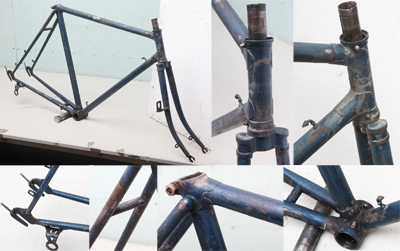
F W EVANS TOURER 1930 21in
Seat Tube (ctt): 21in (53cm)
Top Tube (ctc): 22.5in (57cm)
Rear dropout width: 114mm
Wheel size: 26 x 1 1/4in
Frame tubing: Reynolds HM double butted
Seatpost size: 27.2mm
F W Evans was not himself a framebuilder but rather a man of ideas and a bike shop proprietor. He was editor of Cycling magazine for a couple of years in the very early 20s before setting up his first bike shop in 1922. Framebuilding started shortly afterwards and he soon made a reputation for innovative and quality touring frames. He devised some special features – one early patented feature of his frames was the Evans Direct Lubrication System. Oil ports were provided in the bottom bracket, head tube and hubs enabling these bearings to be easily oiled with an oil gun. They were much copied by other makers but the Evans version actually had little channels to direct the oil onto the bearings. A nice touch which made maintenance easier. More can be found on Evans at: http://www.classiclightweights.co.uk/designs/hsfwevans.html
This F W Evans clubman’s frame was built in 1935. It has many of the special features unique to F W Evans frames – Direct Lubrication system for the bottom bracket and headset bearings and patented fork ends. This was built as a serious touring frame for use with a Cyclo derailleur and Resilion brakes. Its very sound but does need repainting. £145
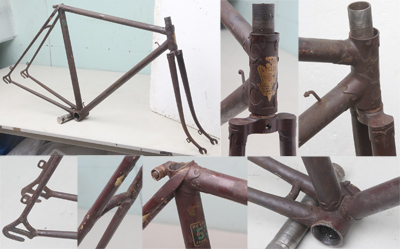
SOUTHERN CYCLES ROAD FRAME 19.5in 1950s
Seat Tube (ctt): 19.5in (49.5cm)
Top Tube (ctc): 21in (53cm)
Rear dropout width: 110mm
Wheel size: 27in or Sprints/700C with a brake drop of 60mm
Frame tubing: Reynolds 531
Seatpost size: 27.2mm
Southern Cycles was run by Jack Wyatt and Stan Butcher in Ascot Parade, Clapham. I think Southern Cycles closed around 1961. This frame was built by Bill Hurlow for them and I think dates from the late 1950s despite the mudguard fittings on the seatstays and fork blades. It’s very typical of Bill’s work from this time. Bill Hurlow was best known for the frames he built for Condors in the 1950s and 1960s. All are superbly built. I rate Bill Hurlow as probably one of the top two or three of the post-war British builders – his work is truly beautiful and accurate. He made a name for himself outside of the cycling world as well as within it and is the only framebuilder I know who has been recognised with an obituary in the British Financial Times. A lot more can be found on Bill Hurlow at: http://www.classiclightweights.co.uk/hurlow.html
This frame is in very sound condition though the paint is very poor – most would want to repaint it. £395
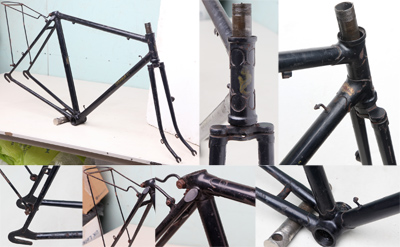
ELLIS CHAMPION CLUBMAN’S FRAME c1946 20in
Seat Tube (ctt): 20in (51cm)
Top Tube (ctc): 21.5in (55cm)
Rear dropout width: 112mm
Wheel size: 26in or Sprints/700C with a brake drop of 57mm
Frame tubing: Reynolds HM double butted
Seatpost size: 27.2mm
Ellis Champion was a very old established frame builder – his catalogues claimed they had been frame builders since 1897 and Percy Ellis finally packed up in the early. 1960s. This frame dates from either the wartime years or just after. In the post-war years his frames always looked very old fashioned but they were exquisitely built with lovely filing clean lug shorelines and very neat clean brazing. Saddle bag supports were a common feature of his frames.
This frame is in very sound condition with no dents or dings I could find but the paint has a number of marks. It’s slightly unusual for an Ellis in having quite fancy hand cut lugs. £225
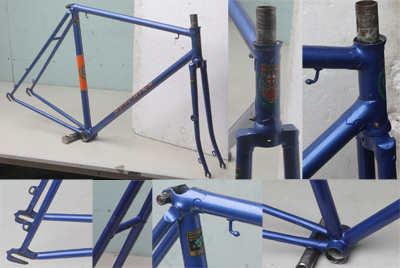
HETCHINS COMPETITION 21in 1937
Seat Tube (ctt): 21in (53cm)
Top Tube (ctc): 21.5in (55cm)
Rear dropout width: 110mm
Wheel size: Sprints/700C with a brake drop of 55mm
Frame tubing: Reynolds 531 double butted
Seatpost size: 27.2mm
This frame is one of the earliest Hetchins Competition frames and was the last frame built in 1937 – it was supplied on 26th January to F R Russell of Wolverhampton who was an established Hetchins dealer… It has Chater Lea bottom bracket threads – I can supply a suitable BB to fit at extra cost… It has been reasonably repainted and this is mostly unmarked.
A lot more can be found about Hetchins at www.hetchins.org Really a rather rare pre-war Hetchins… £525
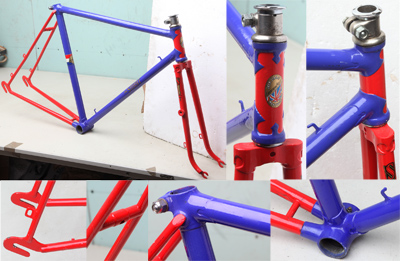
JACK SIBBIT ROAD FRAME 20in 1930s
Seat Tube (ctt): 20in (51cm)
Top Tube (ctc): 21.75in (55.5cm)
Rear dropout width: 110mm
Wheel size: 26in or 700C/sprints with a brake drop of 48mm
Seatpost size: 27.0mm
Frame Tubing: Reynolds 531 double butted
Jack Sibbit was a one of the great pre-war track cyclists winning a silver medal at the 1928 Olympics and 12 National Track titles. There’s masses of information on Jack Sibbitt at: http://www.classiclightweights.co.uk/builders/sibbit-builder.html He set up a shop in Manchester in the 1920s and started building frames many of which were for track use.
Judging by the lugs, Russ shape fork blades, frame angles and other details this frame I think dates from the later 1930s. It has been repainted to a not very high standard – but does appear to be very sound… £175
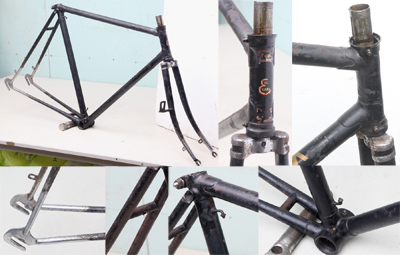
F W EVANS TOURING FRAME 1935 21in
Seat Tube (ctt): 21in (53cm)
Top Tube (ctc): 22in (56cm)
Rear dropout width: 114mm
Wheel size: 26in or Sprints/700C with a brake drop of 57mm
Frame tubing: Reynolds HM double butted
Seatpost size: 27.2mm
F W Evans was not himself a framebuilder but rather a man of ideas and a bike shop proprietor. He was editor of Cycling magazine for a couple of years in the very early 20s before setting up his first bike shop in 1922. Framebuilding started shortly afterwards and he soon made a reputation for innovative and quality touring frames. He devised some special features – one early patented feature of his frames was the Evans Direct Lubrication System. Oil ports were provided in the bottom bracket, head tube and hubs enabling these bearings to be easily oiled with an oil gun. They were much copied by other makers but the Evans version actually had little channels to direct the oil onto the bearings. A nice touch which made maintenance easier. More can be found on Evans at: http://www.classiclightweights.co.uk/designs/hsfwevans.html
This F W Evans clubman’s frame was built in 1935. It has many of the special features unique to F W Evans frames – Direct Lubrication system for the bottom bracket and headset bearings and patented fork ends. The paint and chrome are are in quite a poor state but the rest of the frame is quite sound. £165
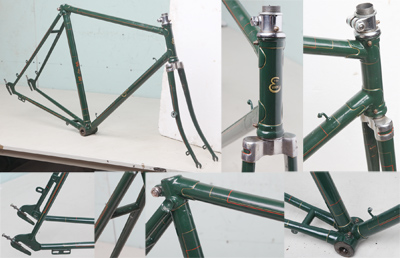
** SPECIAL REDUCED PRICE**
F W EVANS TOURER 1939 21in
Seat Tube (ctt): 21in (53cm)
Top Tube (ctc): 23in (58cm)
Rear dropout width: 115mm
Wheel size: 26in
Frame tubing: Reynolds 531 double butted
Seatpost size: 27.2mm
This F W Evans touring frame was built in 1939 and is designed for use with a Cyclo 3spd Standard gear – it has the braze-on for the gear and tensioning spring on the chainstay. I will supply it with all the parts to complete the headset except the pinch bolt for the headclip. It has many of the special features unique to F W Evans frames – Direct Lubrication system for the bottom bracket and headset bearings and patented fork ends. Additionally it has braze-ons for a rear saddle bag support. F W Evans were very highly regarded by CTC members and many members had special touring frames made to order for them. More can be found on Evans at: http://www.classiclightweights.co.uk/designs/hsfwevans.html
It has been very nicely repainted in a dark green with box lining and will make a really great 1930s classic English tourer. £245
    
Featured Frames
British and American road frames smaller than 21.5in
British and American road frames 21.5in–22.5in
British and American road frames larger than 22.5in
Bargain Basement
Classic Road frames pre-1970 smaller than 21.5in (look above)
Classic Road frames pre-1970 21.5in–22.5in
Classic Road frames pre-1970 larger than 22.5in
Classic Track & Road-Track frames pre-1970
European frames 56cm or smaller
European frames larger than 56cm
Italian frames 56cm or smaller
Italian frames larger than 56cm
Lo-Pro & Retro Time Trial frames
Touring frames
Track frames

|

SHIPPING COSTS
UK: £18
Europe: £35
North America: £90
Japan, Asia, Australasia, Africa, Middle East, South America: £115
Figures above are good estimates, rates may vary for some countries.
Contact us for more info.
CLICK ON the sale images to see a much larger picture!
FRAME CONDITION
Frames are supplied as seen in the pictures unless described otherwise in the text.
Please remember that these frames are generally at least twenty years old and sometimes seventy… In most cases I will know very little of their history but will attempt to describe any problems I can spot – if there are issues I have missed I will always work with the buyer to find a solution.
All frames I sell are in track and straight, with excellent headset threads, bottom bracket shell threads and gear hanger threads if fitted.
I will make every attempt to ascertain whether paint is original, an older repaint or a more recent repaint. Paint quality does vary quite bit…
These categories may be qualified by more detailed description in the text.
Excellent A very useable frame with no obtrusive marks to the paint and no dings or dents. Chrome if present will be free of serious marks unless stated otherwise.
Very Good Perfectly useable frame but with more marks to the paint and chrome if present. Some of the marks may benefit from careful retouching. Generally there will no dents or dings but if present will be small. However if you are concerned about dents/dings with frames in this category please ask me to do an extra check.
Sound Paint and chrome may need redoing depending on how you like your bikes – I appreciate frames with patina which show their age but others may want to repaint. There may be a small ding or two but nothing very significant – older frames often pick up smaller dents which are of no significance to their strength or life. Any more significant dents will be described in the text.
Needing repainting Paint will be poor and in my opinion is not saveable. There may be a small ding or two but nothing very significant – older frames often pick up smaller dents which are of no significance to their strength or life. If there are larger dents they will be described and/or pictured. These are all easily filled by a good framebuilder or frame painter at very little extra cost.
Headsets or bottom brackets fitted to frames are of unknown and unguaranteed condition unless specifically described in the text. Sometimes headsets or bottom brackets will not feel smooth and simply need a service and on other occasions the headset or bottom bracket will need replacing…
For frame without headsets or where you'd like a headset replaced I can offer a fitting service for £15. Please see the headset pages: http://hilarystone.com/headset.html for what is available but please bear in mind that you may need advice on whether a particular headset will fit your frame especially in relation to stack height.
|










